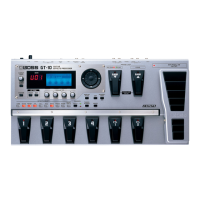13
Function Label What It Does
Internal
Pedal
Curve
IntCurve When INTERNAL PDL is selected as the
control source, this setting determines
the response curve of the internal pedal’s
assigned parameter adjustment.
Wave
Pedal
Rate
WaveRate When WAVE PEDAL is selected as the
control source, this setting determines the
speed at which the wave pedal modulates
the target parameter. (The speed can be a
fixed value or a note value that’s synced
to the GT-10’s master BPM.)
Wave
Pedal
Waveform
Waveform When WAVE PEDAL is selected as the
control source, this setting determines the
smoothness with which the wave pedal
adjusts the target parameter.
About the Target and Source
When working with control assignments, the “target” is what you want to
control, while the “source” is the mechanism with which you control the
target.
TargetSource
When working in the ASSIGN screens, the primary target is the effect or
function you wish to control, while the secondary target is the particular
parameter within that effect or function.
For example, let’s say that you’d like to control a parameter in the chorus
effect. For the primary target, you’d choose “CHORUS.” For the secondary
target, you’d choose the desired chorus parameter, such as On/Off, Rate,
Depth, etc.
Secondary target
Primary target
Primary and secondary target locations on an ASSIGN screen. Scroll down to set the source controller.
We’re using the terms “primary target” and “secondary target” only
for the purposes of this booklet, to help you categorize the many
control assignments that are available. In the GT-10’s display and the
GT-10 Owner’s Manual, both are simply referred to as “Target.”
On the ASSIGN screens, the source is the realtime controller—CTL1, CTL2,
EXP1, etc.—that you wish to use to control the chosen target parameter.
Source
Source location on an ASSIGN screen.
On each of the eight ASSIGN screens, there is a single target/source
relationship. If you want to use a specific source to control multiple
targets at once—or if you want to control a specific target with
multiple sources—simply set up those relationships one by one using
multiple ASSIGN screens.
Available Targets
On the ASSIGN 1-8 screens, you can target nearly any GT-10 effects
parameter or function for realtime control. For a detailed listing of every
available parameter and function, see the TARGET PARAMETER tables in the
“Parameters Guide” chapter in the GT-10 Owner’s Manual.
Another way to see them is on the GT-10 itself: just scroll through the Target
parameters on an ASSIGN screen to see every available parameter and
function, as described in Step 5 of “Making Settings in the ASSIGN Screens”
(coming up on Page 15).

